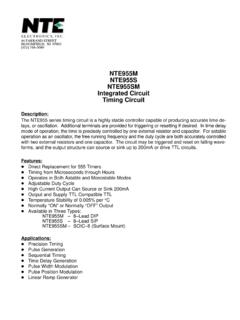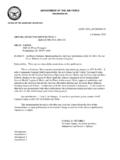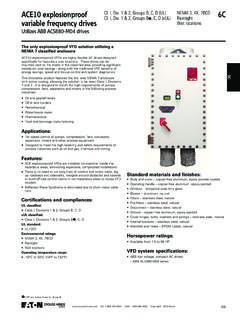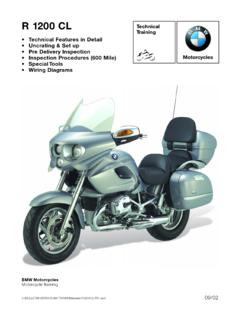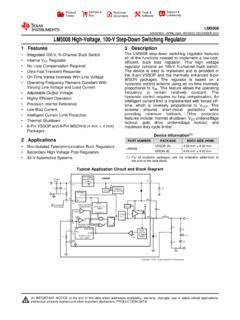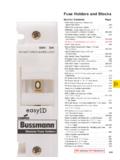Transcription of THE “FLEET THAT NEVER WAS” By Wayne Smith …
1 THE FLEET THAT NEVER WAS By Wayne Smith consultant to alnavco The Special Edition Collector s series consists of models of ships that were proposed and planned but were NEVER built ( NEVER -weres ). All have an historical background even if it was just on paper. It's interesting to imagine how these ships would have performed against ships that were built or against each other. These Superior 1:1200 scale models will be made available from time to time on a limited "Special Production Run" basis. A short history follows for most. The names of those in bold are models that have been produced and made available. Ships that NEVER existed elicit a certain fascination for ship lovers. In many cases they were larger than existing ships and were cancelled for artificial reasons (materials, costs, higher priorities, treaties) rather than being technically impossible. Even these large ships prove the triple constraint of firepower, protection and speed.
2 On any given displacement, increasing one requires the decrease of one or both of the others. To paraphrase: I can make it fast and powerful, but it won t have any armor (battlecruiser) I can make it fast and well protected, but it cannot sink another battleship ( SCHARNHORST) I can make it powerful and well protected but it will be slow (battleship) Every ship suffers from these design constraints and even the largest of the NEVER weres had some limitations. These limitations are noted in the text. The largest of the completed battleships also had design issues. YAMATO was well armed and armored but had inferior torpedo protection and was slower than desired. BISMARCK was fast and relatively well armored but had inadequate firepower and poorly protected turrets. IOWA traded suspect torpedo protection and heavy weather handling for excellent fire-power, good protection and speed. If you want it all, the ship must be very large and very expensive.
3 In general, for the price of the very large ship, two adequate ships could be built which have a better chance of winning the engagement. Suggested Seapower values for many of these ships have been created by Bob Weymouth and are tabulated at the end of the document. Some of the more well-known ships ( MONTANA, H) are already in the Seapower directory. The pictures scattered through the document are also courtesy of Bob Weymouth. The drawings are those of the official US and German design bureaus. At the end of the article are some thoughts on fleet dispositions given some changes in historical decisions. These are the What Ifs that are so fascinating. BB Battleship Dimensions are length x width x depth under water CC Battlecruiser 5x 2 means five twin mounts CB Large Cruiser 4x3 means four triple mounts CA Cruiser (Armored, later Heavy) CL Cruiser, Light Type Name Tons Dimensions Armament A107 BB Montana 60,500 921x121x36 12-16 /50, 20-5 /54 A120 BB South Dakota 1921 42,500 684x105x33 12-16 , 16-6 , 8-5 A125 BB BB65D 60,600 921x121x36 12-16 /50(quad), 12-6 /47 A126 BB Tillman IV-2 80,000 975x108x33 15-18 , 12-6 , 8-5 A127 BB Georgia (MT II) 60,500 921x121x36 8-18 /50, 12-6 /47 DP A128 BB Virginia (MT III) 60,500 921x121x36 9-18 /50, 12-6 /47 DP A130 BB BB 1922 44,500 684x108x33 8-18 , 18-6 , 8-5 A131 BB BB 1923 52,000 800x108x33 12-18 , 12-6 , 8-5 A132 BB BB65A 45,000 888x108x38 12-16 , 20-5 /38 A133 BB BB65(I)
4 45,000 888x108x38 9-18 , 20-5 /38 A134 BB Maximum BB 1934 66,000 975x107x33 8-20 , 20-5 /38 A135 BB BB1917 35,700 644x100x30 10-16 , 22-6 , 4-3 A136 BB BB65C 43,800 888x108x36 12-16 , 20-5 A137 BB BB1934-2 35,000 745x102x31 8-16 , 14-5 , A138 BB BB1937 XVI 35,000 740x108x32 12-14 , 16-5 , A141A BB BB65-8A 67,000 1050x120x35 12-16 , 20-5 A141B BB BB65-8B 75,000 1050x122x36 12-18/48 , 12-6 DP A142 BB Iowa Flight Deck 45,000 888x108x36 6-16 , 4-5 , 122 missiles A143 BB Tillman D1/D4 80,000 975x108x38 24-16/50 , 16-6 , A144 BB BB1926 35,000 625x106x31 10-16 /50, 16-6 , 8-5 A202 CC Lexington 1921 43,500 874x106x32 8-16 /50, 16-6 , 8-5 A203 CC Lexington 1916 33,500 874x92x30 10-14 /50,18-5 A204 BB Design D, 1918 54,500 874x106x32 12-16 /50,16-6 , A205 CB CA2D 38,700 888x104x31 12-12 /50, 16-5 A206 CB CA Scheme 2 15,750 716x72x24 12-8 /55, 12-5 A207 CB CAC 20,000 808x77x25 12-8 /55, 12-5 A208 CB CA, Scheme 3 17,300 710x74x25 6-12 /50, 12-5 A209 CC CC1933 33,500 775x92x32 9-14 /45, 16-5 /38 A210 CB CA Scheme M 22,500 735x82x26 10-10 /50, 12-5 A313 CA Scout Cruiser C-1 10,000 620x57x18 7-8 /55, 4-5 , 4-3 , 6 TT A510A CV CV-A 44,500 900x111x32 9-8 /55,8-5 A510B CV CV-B 38,500 900x104x32 16-6 /47 B103 BB Lion 40,550 793x105x33 9-16 , , 84 2pdr B110 BB Vanguard 42,300 814x108x34 8-15 , , 73 2pdr B111 BB Super Lion (16E-38) 48,500 850x108x34 12-16 , , 84-2pdr B112 BB N3 (1922) 48,500 815x106x32 9-18 , 16-6 , B113 BB BB1935 15A/B 35,000 770x104x31 9-15 , , 32-2pdr B114 BB Lion Hybrid 44,750 800x112x30 6-16 , , 14 AC B204 CC Invincible 1921(G3)
5 48,400 856x106x36 9-16 , 16-6 , B205 CC Hood 1944 41,200 860x104x32 8-15 , , 56 2pdr B206 CC F3 35,000 740x106x32 9-15 , 8-6 , 32 2pdr D201 CC Dutch 1047 28,000 778x98x26 9-11 , , 14-40mm F105 BB Gascogne 40,270 813x108x32 8-15 , 9-6 , F106 BB Alsace 45,000 900x108x31 12-15 , 12-6 , F901 BB Normandie 1916 25,230 578x89x30 , G103 BB H 39, 12x15 56,200 873x121x33 12-15 , , G104 BB H 39, 8x16 56,200 873x121x33 8-16 , , G105 BB H44 128,930 1200x169x44 8-20 , , G203 CC OPQ 31,152 814x98x29 6-15 , , , 12 TT G207 CB Kreuzer P 19,679 755x89x28 6-11 , , G208 CC KW45 45,000 984x111 8-15 , , , 8 TT G405 CL Kreuzer M 7,800 600x56x18 , , 8-21 TT I405 CL Ciano 10-6 /55, 10-90mm J108 BB Tosa 38,500 768x100x31 10-16 , ,8-24 TT J109 BB Super Yamato(798) 64,000 863x127x36 6-20 , , J110 BB Number 13 47,500 900x101x31 , , 8-24 TT J111 BB A-140A 68,000 935x132x34 9-18 , , 12-5 J112 BB A-140/A2 68,000 935x132x34 8-18 , , 12-5 J113 BB A-140/B2 70,000 935x132x34 8-20 , , 12-5 J114 BB Fujimoto BB 35,000 762x105x28 9-16 , 12-6 , AA J115 BB Hiraga BB 35,000 761x105x29 10-16 , 16-6 , AA J201 CC Amagi 40,000 820x101x31 10-16 , , 8-24 TT J202 CC B-65 (795) 31,400 808x89x29 9-12 , , 8-24 TT J203 CC Japanese Vanguard 35,000 848x89x30 8-14 , , 8-24 TT R101 BB Sovetskii Soyuz 59,150 889x127x33 9-16 ,12-6 , ,32-37mm R102 BB Gibbs & Cox D 45,000 845x113x33 10-16 , 20-5 , R103 BB Project 24, (XIII)
6 72,950 925x132x38 9-16 , 16-5 , 48-45mm R104 BB UP 41 R201 CC Kronstadt 35,240 813x103x28 9-12 , 8-6 , ,24-37mm R202 CC Stalingrad 38,540 897x105x30 9-12 , , 24-45mm The following is a table showing the construction of the completed and some incomplete or projected battleships in WWII. Note that 11 of 28 completed ships were sunk, only 1 Allied. Also note that the US ships were completed more quickly than any other countries. Laid down to launching Launching to commissioning In service xxx Projected Sunk 1933 34 35 36 37 38 39 40 41 42 43 44 45 Fr Dunkerque Fr Strassburg Fr Richeliue Fr Jean Bart Fr Clemenceau x x x x x x x x x x x Fr Gascogne x x x x x x x x x x x x It Vittorio Veneto It Littorio It Roma It Impero x x x x x x x x x x x x Ge Scharnhorst Ge Gneisnau Ge Bismarck Ge Tirpitz Ge H x x x x x x x x x x x x x Ge J x x x x x x x x x x x x x GB King George V GB Prince of Wales GB Duke of York
7 GB Anson GB Howe GB Lion x x x x x x x x x x x x x x GB Temeraire x x x x x x x x x x x x x x GB Vanguard Jp Yamato Jp Musashi Jp Shinano Jp #111 x x x x x x X SU Sovetzky Soyuz x x x SU Sov Ukraina x x x SU Sov Rossiya x x x x x x SU Sov Belorussiya x x x x X US N Carolina US Washington US S Dakota US Massachussetts US Indiana US Alabama US Iowa US New Jersey US Wisconsin US Missouri US Kentucky US Illinois US Montana x x x x x x x x x x US Ohio x x x x x x x x x x US Maine US N Hampshire US Louisiana A135 BB 1917 The story of many un-built US battleships starts with the story of BB 1917 and is tied to Secretary of the Navy Josephus Daniels.
8 Daniels tried to control the growth of battleships by restricting them to incremental changes instead of significant growth. This is a study in futility where the US could have had the best individual battleships in the world but were hamstrung by politics. The 16 gun was approved by the General Board on 11/22/1911 but Daniels restricted the study to blueprints only. On 10/22/1912 he authorized a secret prototype which was successfully fired in August 1914. It was superior to both the British and German 15 guns. Battleship 1915 (becoming the New Mexico class) could mount either 12-14 or 8 of the new 16 . In September 1913 (one year before the gun was successfully fired), the board voted for a larger ship with 10-16 . By October 6 sketch designs were available with 3 presented below. One of these alternatives was the PENNSYLVANIA armed with 8-16 . All of these were more expensive than the PA so the NEW MEXICO S were only slightly improved PA.
9 In March 1914 characteristics for BB 1916 were submitted but Daniels ruled in July, 1914 (month prior to the 16 test firing) that the TENNESSE would duplicate the NEW MEXICO. In May, 1915 the fiasco was repeated. Previous arguments had centered on the merits of the 14 vs. 16 when it was not appreciated that battle ranges would increase significantly and at shorter ranges, the more numerous 14: was a better weapon. The increased battle ranges in the North Sea and longer range torpedoes proved the efficacy of Scheme #3 of 1913. It now became the basis of BB 1917. The Superior model of BB1917 is represented by Scheme 166 which mounted their guns in a TEXAS arrangement. It is unfortunate that NEW MEXICO was not a PENNSYLVANIA with 8-16 , disappointing that BB1917 was not the basis of the TENNESSEE and a crime they were not built in place of the MARYLANDs. Oct 1913 #1 Oct 1913 #3 Oct 1913 # (PA hull) 166 Displacement 39,500 tons 35,500 tons 35,700 tons Length 695 650 644 Width 99 96 100 Draft 31 30 30 Speed 21 knots 21 knots Armament 10-16 /45(5x2) 10-16 /45 (5x2) 10-16:/45 (5x2) 22-5 /51(22x1) 22-5 /51(22x1) 22-6 /53 4-3 AA Armor belt: 16 Deck/Splinter: 3 3 / A120 SOUTH DAKOTA 1921 These were the last of the US dreadnoughts begun with the NEVADA.
10 Secretary of the Navy Josephus Daniels finally relented on the size of US battleships with this design. These represented a 30% increase in size from the Colorado, a 50% increase in firepower and 2 knots more speed. Final designs were completed in January 1917 (same time frame as the Tillman IV-2!) with 3 to be laid down in the fall of 1917 and the next three in 1918. The declaration of war fatally delayed construction with them being scrapped under the terms of the Washington Treaty. These ships represented the ultimate in US dreadnoughts and continued the American innovation of thick deck armor, four turrets and endurance for Pacific warfare. World War II experience demonstrated that early hits on fire control (BISMARCK, SCHARNHORST), steering positions (HIEI) or overwhelming numbers of shells (FUSO) were more frequent and important than penetrating hits. Mounting more guns than any of their contemporaries, having better ballistics with the 16 /50, with adequate armor, excellent underwater protection and decent speed, they would have proven formidable opponents even though they weighed 5,000 tons less than the largest of the British and Japanese ships.


